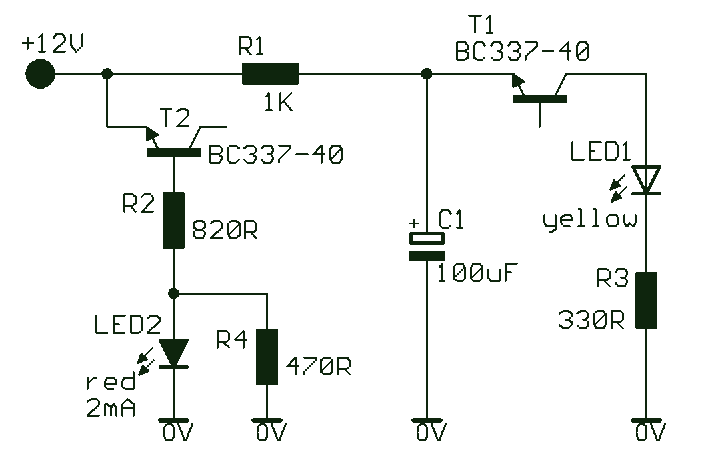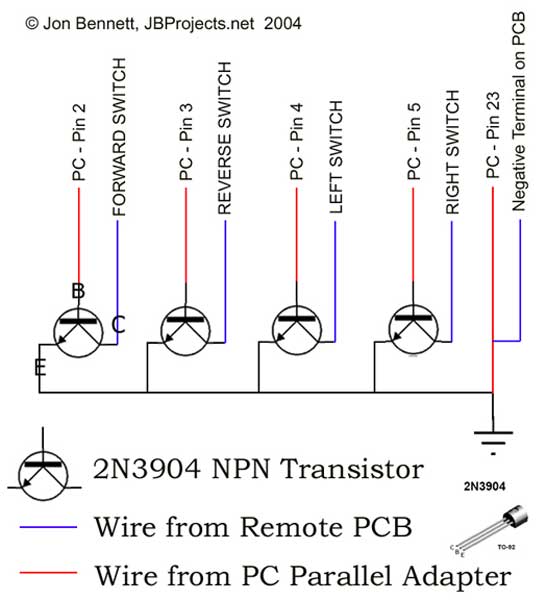
LED Volt Meter

This circuit is a simple LED voltmeter designed to monitor the charge level of lead-acid or tubular batteries. The terminal voltage of the battery is displayed through four LED indicators. The nominal terminal voltage for a fully charged lead-acid battery is 13.8 volts, while for a tubular battery, it is 14.8 volts. The LED voltmeter utilizes four Zener diodes to activate the LEDs at their specific breakdown voltages. Typically, a Zener diode requires an excess of 1.6 volts above its rated value to reach the breakdown threshold. When the battery voltage is 13.6 volts or higher, all Zener diodes enter breakdown, causing all LEDs to illuminate. Conversely, if the battery voltage falls below 10.6 volts, all LEDs remain off. Therefore, the illumination of the LEDs corresponds to the terminal voltage of the battery, lighting up sequentially or turning off as the voltage changes.
The LED voltmeter circuit is structured to provide a visual representation of battery voltage levels through a series of four LEDs, each corresponding to specific voltage thresholds. The Zener diodes are strategically selected based on their breakdown voltages, which determine the activation points for each LED.
In this configuration, the first LED may be activated at a voltage of approximately 10.6 volts, indicating a low charge level. The second LED could light up at around 12.0 volts, signaling a moderate charge. The third LED might illuminate at 13.6 volts, indicating a high charge level for a lead-acid battery, while the fourth LED activates at 14.8 volts, representing a fully charged tubular battery.
The circuit operates by connecting the battery terminals to the input of the Zener diodes. As the battery voltage changes, the corresponding Zener diode will reach its breakdown voltage, allowing current to flow through and light up the associated LED. This creates a clear and intuitive display of the battery's charge status.
To enhance the performance and reliability of the circuit, it is advisable to include a current-limiting resistor in series with each LED. This resistor will prevent excessive current from damaging the LEDs while ensuring they operate within their specified parameters. Additionally, the circuit can be powered directly from the battery being monitored, eliminating the need for an external power supply.
In summary, this simple LED voltmeter circuit provides an effective means of monitoring the charge level of lead-acid and tubular batteries through a straightforward visual indicator system, utilizing Zener diodes for precise voltage detection and LED illumination.Here is a Simple LED Volt meter to Monitor the charge level in Lead Acid Battery or Tubular battery. The terminal voltage of the battery is indicated through a four level LED indicators. The nominal terminal voltage of a Lead Acid battery is 13. 8 volts and that of a Tubular battery is 14. 8 volts when fully charged. The LED voltmeter uses four Zene r diodes to light the LEDs at the precise breakdown voltage of the Zener diodes. Usually the Zener diode requires 1. 6 volts in excess than its prescribed value to reach the breakdown threshold level. When the battery holds 13. 6 volts or more, all the Zener breakdown and all LEDs light up. When the battery is discharged below 10. 6 volts, all the LEDs remain dark. So depending on the terminal voltage of the battery, LEDs light up one by one or turns off. 🔗 External reference
The LED voltmeter circuit is structured to provide a visual representation of battery voltage levels through a series of four LEDs, each corresponding to specific voltage thresholds. The Zener diodes are strategically selected based on their breakdown voltages, which determine the activation points for each LED.
In this configuration, the first LED may be activated at a voltage of approximately 10.6 volts, indicating a low charge level. The second LED could light up at around 12.0 volts, signaling a moderate charge. The third LED might illuminate at 13.6 volts, indicating a high charge level for a lead-acid battery, while the fourth LED activates at 14.8 volts, representing a fully charged tubular battery.
The circuit operates by connecting the battery terminals to the input of the Zener diodes. As the battery voltage changes, the corresponding Zener diode will reach its breakdown voltage, allowing current to flow through and light up the associated LED. This creates a clear and intuitive display of the battery's charge status.
To enhance the performance and reliability of the circuit, it is advisable to include a current-limiting resistor in series with each LED. This resistor will prevent excessive current from damaging the LEDs while ensuring they operate within their specified parameters. Additionally, the circuit can be powered directly from the battery being monitored, eliminating the need for an external power supply.
In summary, this simple LED voltmeter circuit provides an effective means of monitoring the charge level of lead-acid and tubular batteries through a straightforward visual indicator system, utilizing Zener diodes for precise voltage detection and LED illumination.Here is a Simple LED Volt meter to Monitor the charge level in Lead Acid Battery or Tubular battery. The terminal voltage of the battery is indicated through a four level LED indicators. The nominal terminal voltage of a Lead Acid battery is 13. 8 volts and that of a Tubular battery is 14. 8 volts when fully charged. The LED voltmeter uses four Zene r diodes to light the LEDs at the precise breakdown voltage of the Zener diodes. Usually the Zener diode requires 1. 6 volts in excess than its prescribed value to reach the breakdown threshold level. When the battery holds 13. 6 volts or more, all the Zener breakdown and all LEDs light up. When the battery is discharged below 10. 6 volts, all the LEDs remain dark. So depending on the terminal voltage of the battery, LEDs light up one by one or turns off. 🔗 External reference





